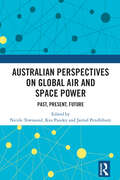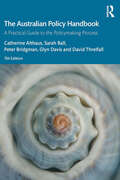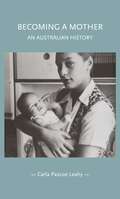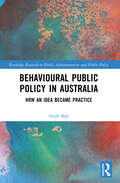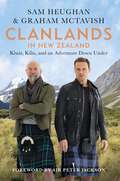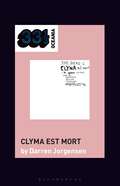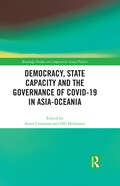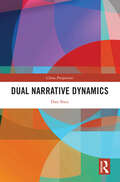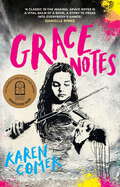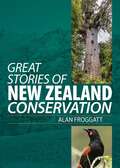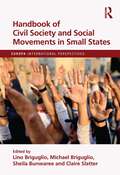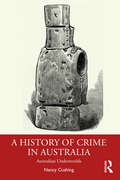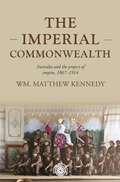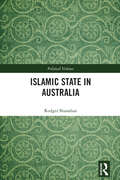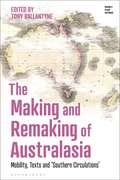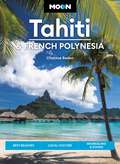- Table View
- List View
Australian Perspectives on Global Air and Space Power: Past, Present, Future
by Nicole Townsend Kus Pandey Jarrod PendleburyThis book surveys historical and emerging global air and space power issues and provides a multidisciplinary understanding of the application of air and space power in the past and present, as well as exploring potential future challenges that global air forces may face. Bringing together leading and emerging academics, professionals, and military personnel from Australia within the field of air and space power, this edited collection traces the evolution of technological innovations, as well as the ethical and cultural frameworks which have informed the development of air and space power in the 20th and 21st centuries, and contemplates its future. It covers topics such as the insurgent use of drones, the ethics of air strikes, the privatisation of air power, the historical trajectory of air power strategy, and the sociological implications of an ‘air force’ identity. While many of the chapters use Australian-based case studies for their analysis, they have broader applicability to a global readership, and several chapters examine other nations’ experiences, including those of the United States, and the United Kingdom. This accessible, illuminating book is an important addition to contemporary air and space power literature, and will be of great interest to students and scholars of air power, air warfare, military and international history, defense studies, and contemporary strategic studies, as well as military professionals.
The Australian Policy Handbook: A Practical Guide to the Policymaking Process
by Catherine Althaus Sarah Ball Peter Bridgman Glyn Davis David ThrelfallThe seventh edition of this classic handbook on the policy process is fully updated, featuring new material on policy making amid local and global disruption, the contestable nature of modern policy advice, commissioning and contracting, public engagement and policy success and failure. The Australian Policy Handbook shows how public policy permeates every aspect of our lives. It is the stuff of government, justifying taxes, driving legislation and shaping our social services. Public policy gives us roads, railways and airports, emergency services, justice, education and health services, defence, industry development and natural resource management. While politicians make the decisions, public servants provide analysis and support for those choices. This updated edition includes new visuals and introduces a series of case studies for the first time. These cases—covering family violence, behavioural economics, justice reinvestment, child protection and more—illustrate the personal and professional challenges of policymaking practice. Drawing on their extensive practical and academic experience, the authors outline the processes used in making public policy. They systematically explain the relationships between political decision makers, public service advisers, community participants and those charged with implementation. The Australian Policy Handbook remains the essential guide for students and practitioners of policy making in Australia.
The Australian Policy Handbook: A Practical Guide to the Policymaking Process
by Catherine Althaus Sarah Ball Peter Bridgman Glyn Davis David ThrelfallThe seventh edition of this classic handbook on the policy process is fully updated, featuring new material on policy making amid local and global disruption, the contestable nature of modern policy advice, commissioning and contracting, public engagement and policy success and failure. The Australian Policy Handbook shows how public policy permeates every aspect of our lives. It is the stuff of government, justifying taxes, driving legislation and shaping our social services. Public policy gives us roads, railways and airports, emergency services, justice, education and health services, defence, industry development and natural resource management. While politicians make the decisions, public servants provide analysis and support for those choices. This updated edition includes new visuals and introduces a series of case studies for the first time. These cases—covering family violence, behavioural economics, justice reinvestment, child protection and more—illustrate the personal and professional challenges of policymaking practice. Drawing on their extensive practical and academic experience, the authors outline the processes used in making public policy. They systematically explain the relationships between political decision makers, public service advisers, community participants and those charged with implementation. The Australian Policy Handbook remains the essential guide for students and practitioners of policy making in Australia.
Becoming a mother: An Australian history (Gender in History)
by Carla Pascoe LeahyBecoming a mother charts the diverse and complex history of Australian mothering for the first time, exposing the ways it has been both connected to and distinct from parallel developments in other industrialised societies. In many respects, the historical context in which Australian women come to motherhood has changed dramatically since 1945. And yet examination of the memories of multiple maternal generations reveals surprising continuities in the emotions and experiences of first-time motherhood.Drawing upon interdisciplinary insights from anthropology, history, psychology and sociology, Carla Pascoe Leahy unpacks this multifaceted rite of passage through more than 60 oral history interviews, demonstrating how maternal memories continue to influence motherhood today. Despite radical shifts in understandings of gender, care and subjectivity, becoming a mother remains one of the most personally and culturally significant moments in a woman’s life.
Becoming a mother: An Australian history (Gender in History)
by Carla Pascoe LeahyBecoming a mother charts the diverse and complex history of Australian mothering for the first time, exposing the ways it has been both connected to and distinct from parallel developments in other industrialised societies. In many respects, the historical context in which Australian women come to motherhood has changed dramatically since 1945. And yet examination of the memories of multiple maternal generations reveals surprising continuities in the emotions and experiences of first-time motherhood.Drawing upon interdisciplinary insights from anthropology, history, psychology and sociology, Carla Pascoe Leahy unpacks this multifaceted rite of passage through more than 60 oral history interviews, demonstrating how maternal memories continue to influence motherhood today. Despite radical shifts in understandings of gender, care and subjectivity, becoming a mother remains one of the most personally and culturally significant moments in a woman’s life.
Behavioural Public Policy in Australia: How an Idea Became Practice (Public Administration and Public Policy)
by Sarah BallUsing rich ethnographic data and first-hand experience, Ball presents a detailed account of Australia’s attempts to incorporate behavioural insights into its public policy. Ball identifies three competing interpretations of behavioural public policy, and how these interpretations have influenced the use of this approach in practice. The first sees the process as an opportunity to introduce more rigorous evidence. The second interpretation focuses on increasing compliance, cost savings and cutting red tape. The last focuses on the opportunity to better involve citizens in policy design. These interpretations demonstrate different ‘solutions’ to a series of dilemmas that the Australian Public Service, and others, have confronted in the last 50 years, including growing politicisation, technocracy and a disconnect from the needs of citizens. Ball offers a detailed account of how these priorities have shaped how behavioural insights have been implemented in policy-making, as well as reflecting on the challenges facing policy work more broadly. An essential read for practitioners and scholars of policy-making, especially in Australia.
Behavioural Public Policy in Australia: How an Idea Became Practice (Public Administration and Public Policy)
by Sarah BallUsing rich ethnographic data and first-hand experience, Ball presents a detailed account of Australia’s attempts to incorporate behavioural insights into its public policy. Ball identifies three competing interpretations of behavioural public policy, and how these interpretations have influenced the use of this approach in practice. The first sees the process as an opportunity to introduce more rigorous evidence. The second interpretation focuses on increasing compliance, cost savings and cutting red tape. The last focuses on the opportunity to better involve citizens in policy design. These interpretations demonstrate different ‘solutions’ to a series of dilemmas that the Australian Public Service, and others, have confronted in the last 50 years, including growing politicisation, technocracy and a disconnect from the needs of citizens. Ball offers a detailed account of how these priorities have shaped how behavioural insights have been implemented in policy-making, as well as reflecting on the challenges facing policy work more broadly. An essential read for practitioners and scholars of policy-making, especially in Australia.
Clanlands in New Zealand: Kiwis, Kilts, and an Adventure Down Under
by Sam Heughan Graham McTavish*With a foreword by Sir Peter Jackson*Buckle up, grab a dram, and get ready for another unforgettable wild ride.They're back! Stars of Outlander, Sam Heughan and Graham McTavish are no strangers to the rugged beauty of Scotland. But this time they're setting their sights on a new horizon: New Zealand.Join our intrepid Scotsmen on their latest epic adventure across The Land of the Long White Cloud in this thrilling follow-up to Clanlands. Setting out to explore a country that Graham calls home, and that Sam has longed to visit, these sturdy friends immerse themselves in all that New Zealand has to offer: stunning landscapes, rich history, world-class food and drink, and - much to Graham's mounting anxiety and Sam's deep satisfaction - famously adrenaline-fuelled activities! As ever there's not nearly enough space in their trusty camper van and with plenty of good-natured competition and tormenting to go around, Sam and Graham's friendship is put to the test once again. Along the way we learn about the length and breadth of this jewel of the Southern Seas, exploring the fascinating story of its people while testing the very limits of Graham's sanity.Like the very best buddy movie sequel, this latest instalment is full of unforgettable experiences and loveable characters and promises to be an even more memorable ride with two of the most entertaining travel companions around.So, say goodbye to your inhibitions and kia ora to New Zealand like you've never seen it before.
The Dead C’s Clyma est mort (33 1/3 Oceania)
by Darren JorgensenThe Dead C's Clyma est mort (1993) is the record of a live gig for one person. Tom Lax was running the Siltbreeze label in Philadelphia and had come to New Zealand to meet the artists he was releasing. He heard The Dead C at their noisy, improvised best, turning rock music on its head with a free-form style of blaring, loosely organised sound. Leading a second wave of music from Dunedin, New Zealand, The Dead C were an assault against the kind of jangly pop that had made the Dunedin Sound famous during the 1980s. This book uses The Dead C and in particular their album Clyma est mort (1993) to offer insights into the way the best of rock music plays vertigo with our senses, illustrating a sonic picture of freedom and energy. It places the album into the history of independent music in New Zealand, and into an international context of independent labels posting, faxing and phoning each other.
Democracy, State Capacity and the Governance of COVID-19 in Asia-Oceania (Routledge Studies on Comparative Asian Politics)
by Aurel Croissant Olli HellmannThis book examines the public health responses to the COVID-19 pandemic in the Asia-Oceania region and their implications for democratic backsliding in the period January 2020 to mid-2021. The contributions discuss three key questions: How did political institutions in Asia-Oceania create incentives for effective public health responses to the COVID-19 outbreak? How did state capacities enhance governments’ ability to implement public health responses? How have governance responses affected the democratic quality of political institutions and processes? Together, the analyses reveal the extent to which institutions prompted an effective public health response and highlights that a high-capacity state was not a necessary condition for containing the spread of COVID-19 during the early phase of the pandemic. By combining quantitative and qualitative analyses, the volume also shows that the effect of the COVID-19 pandemic on the quality of democratic institutions has been uneven across Asia-Oceania. Guided by a comprehensive theoretical framework, this will be an invaluable resource for scholars and students of political science, policy studies, public health and Asian studies.
Democracy, State Capacity and the Governance of COVID-19 in Asia-Oceania (Routledge Studies on Comparative Asian Politics)
by Aurel Croissant Olli HellmannThis book examines the public health responses to the COVID-19 pandemic in the Asia-Oceania region and their implications for democratic backsliding in the period January 2020 to mid-2021. The contributions discuss three key questions: How did political institutions in Asia-Oceania create incentives for effective public health responses to the COVID-19 outbreak? How did state capacities enhance governments’ ability to implement public health responses? How have governance responses affected the democratic quality of political institutions and processes? Together, the analyses reveal the extent to which institutions prompted an effective public health response and highlights that a high-capacity state was not a necessary condition for containing the spread of COVID-19 during the early phase of the pandemic. By combining quantitative and qualitative analyses, the volume also shows that the effect of the COVID-19 pandemic on the quality of democratic institutions has been uneven across Asia-Oceania. Guided by a comprehensive theoretical framework, this will be an invaluable resource for scholars and students of political science, policy studies, public health and Asian studies.
Dual Narrative Dynamics (China Perspectives)
by Dan ShenCombining narratological and stylistic methods, this book theorizes dual narrative dynamics comprised of plot development and covert progression, and demonstrates the consequences for the interpretation of literary works.In narratives with such dynamics, writers work simultaneously with overt and covert trajectories of signification, establishing a range of relationships between them. The two parallel narrative movements may complement, contradict or even subvert each other, and these relationships significantly influence readers’ understanding not just of events but also of characters, themes, and aesthetic values. The book provides a systematic theoretical account of such previously neglected dual narrative dynamics, substantiated and enriched by the textual analysis of works by Ambrose Bierce, Kate Chopin, Franz Kafka, and Katherine Mansfield. The study explores the many ways that these authors have used dual dynamics to increase the power of their narratives. In addition, the book identifies the challenges such dual dynamics present not only for narratology but also for stylistics and translation studies, and it develops sound and provocative proposals for meeting those challenges.In taking an interdisciplinary approach, this book will appeal to scholars and students in the fields of narrative and literary theory, literary criticism, literary stylistics, and translation studies.
Dual Narrative Dynamics (China Perspectives)
by Dan ShenCombining narratological and stylistic methods, this book theorizes dual narrative dynamics comprised of plot development and covert progression, and demonstrates the consequences for the interpretation of literary works.In narratives with such dynamics, writers work simultaneously with overt and covert trajectories of signification, establishing a range of relationships between them. The two parallel narrative movements may complement, contradict or even subvert each other, and these relationships significantly influence readers’ understanding not just of events but also of characters, themes, and aesthetic values. The book provides a systematic theoretical account of such previously neglected dual narrative dynamics, substantiated and enriched by the textual analysis of works by Ambrose Bierce, Kate Chopin, Franz Kafka, and Katherine Mansfield. The study explores the many ways that these authors have used dual dynamics to increase the power of their narratives. In addition, the book identifies the challenges such dual dynamics present not only for narratology but also for stylistics and translation studies, and it develops sound and provocative proposals for meeting those challenges.In taking an interdisciplinary approach, this book will appeal to scholars and students in the fields of narrative and literary theory, literary criticism, literary stylistics, and translation studies.
Grace Notes
by Karen ComerThis song has a grace note,a tiny note that's there for embellishmentbut can easily be ignored,not played.Tonight, I add it in -just because.We can all do with an extra noteof grace.Grace Dalfinch is a talented violinist who longs to play contemporary music in bars, but her mum forbids her. James Crux is an aspiring street artist who promised his dad he wouldn't paint in public until he's finished school. When Crux witnesses Grace's impromptu performance on a deserted tram, he's inspired to paint her and her violin; and when Grace stumbles across her portrait in a Melbourne alley by an anonymous street artist, she sets out to find its creator.Grace Notes is a debut YA verse novel, set in one of the most locked-down cities in the world - Melbourne, 2020. For fans of Cath Crowley and Pip Harry.'A classic in the making; Grace Notes is a vital balm of a book, a story to press into everybody's hands.'DANIELLE BINKS'Poetry, music and art, woven together in an uplifting story about endless lockdowns and first love.'NOVA WEETMAN'Comer captures the beats of Melbourne's 2020 and the unique experience of a generation of teens in one of the most locked-down cities in the world.'Books+Publishing'Heart and soul triumph over Covid lockdowns and restrictions . . . Karen has used the verse novel to beguile, dance and demand layers of emotion and depth that only poetry can sustain. A masterful debut!'LORRAINE MARWOOD'Like the grace note of the title, this beautiful story strikes the perfect tone, mixing colour, light and music at a time when we needed it most.'NICOLE HAYES
Handbook of Civil Society and Social Movements in Small States (Europa International Perspectives)
by Lino Briguglio Claire Slatter Michael Briguglio Sheila BunwareeThis volume is unique because of its focus on small states. There are many studies on civil society and social movements, but none that specifically deal with this category of countries. As is well known, small states have particular characteristics, including a limited ability to reap the benefits of economies of scale, a high degree of exposure to forces outside their control, and the proximity of politicians to the voters, often leading to clientelistic relationships and patronage networks. The small island developing states have the additional problem of high environmental vulnerability, with some also dealing with disproportionate ecological footprints. These factors have a bearing on the organization and performance of civil society organizations and social movements, as explained in several chapters of this book. The volume is organized in three parts, dealing with aspects of civil society and social moments in small states in the political, social and environmental spheres, respectively. Various definitions of civil society are proposed in the chapters, but most authors associate the term with organized groups, operating in the interest of citizens, independently of government and commercial business, including various forms of non-governmental organizations (NGOs). Civil society also encompasses social movements, which are considered to be loosely organized collective campaigns in pursuit of social goals. These two terms are sometimes used interchangeably; however, some authors argue that social movements tend to engage in ‘contentious politics’ including protests, while NGOs engage through more organized and institutional routes.
Handbook of Civil Society and Social Movements in Small States (Europa International Perspectives)
by Lino Briguglio Claire Slatter Michael Briguglio Sheila BunwareeThis volume is unique because of its focus on small states. There are many studies on civil society and social movements, but none that specifically deal with this category of countries. As is well known, small states have particular characteristics, including a limited ability to reap the benefits of economies of scale, a high degree of exposure to forces outside their control, and the proximity of politicians to the voters, often leading to clientelistic relationships and patronage networks. The small island developing states have the additional problem of high environmental vulnerability, with some also dealing with disproportionate ecological footprints. These factors have a bearing on the organization and performance of civil society organizations and social movements, as explained in several chapters of this book. The volume is organized in three parts, dealing with aspects of civil society and social moments in small states in the political, social and environmental spheres, respectively. Various definitions of civil society are proposed in the chapters, but most authors associate the term with organized groups, operating in the interest of citizens, independently of government and commercial business, including various forms of non-governmental organizations (NGOs). Civil society also encompasses social movements, which are considered to be loosely organized collective campaigns in pursuit of social goals. These two terms are sometimes used interchangeably; however, some authors argue that social movements tend to engage in ‘contentious politics’ including protests, while NGOs engage through more organized and institutional routes.
A History of Crime in Australia: Australian Underworlds
by Nancy CushingThis book provides a lively and accessible account of Australia’s most prominent crimes and criminals of the nineteenth and twentieth century and offers an informative background for those seeking to understand crimes committed today. A History of Crime in Australia examines the imposition of English law on this ancient continent, and how its operation affected both transported offenders from Great Britain and Ireland, and the Aboriginal and Torres Strait Islander peoples whose own systems of Law were overlaid. Drawing upon cutting-edge research in the field, original work by the author, and essays from leading crime history researchers, it addresses the question of whether there was an Australian underworld. In doing so, it provides background for well known offenders including bushranger Ned Kelly and the razor gangs of the 1920s and for sensational crimes like the Mount Rennie Outrage, the Pyjama Girl Mystery and the Shark Arm Murder and the miscarriage of justice following the disappearance of Azaria Chamberlain at Uluru in 1980. Through these case studies, the book draws out points of tension and cohesion within Australian society, exposing the enduring anxiety around those who were considered to be outsiders, and how the criminal justice system was used to manage these concerns. This book includes a guide to conducting research in the field of Australian crime history and sources for further study. Designed as an introductory text for students, this book will be of interest to those studying criminology and crime history, and anyone who would like to deepen their understanding of crime’s place in Australia’s social and cultural history.
A History of Crime in Australia: Australian Underworlds
by Nancy CushingThis book provides a lively and accessible account of Australia’s most prominent crimes and criminals of the nineteenth and twentieth century and offers an informative background for those seeking to understand crimes committed today. A History of Crime in Australia examines the imposition of English law on this ancient continent, and how its operation affected both transported offenders from Great Britain and Ireland, and the Aboriginal and Torres Strait Islander peoples whose own systems of Law were overlaid. Drawing upon cutting-edge research in the field, original work by the author, and essays from leading crime history researchers, it addresses the question of whether there was an Australian underworld. In doing so, it provides background for well known offenders including bushranger Ned Kelly and the razor gangs of the 1920s and for sensational crimes like the Mount Rennie Outrage, the Pyjama Girl Mystery and the Shark Arm Murder and the miscarriage of justice following the disappearance of Azaria Chamberlain at Uluru in 1980. Through these case studies, the book draws out points of tension and cohesion within Australian society, exposing the enduring anxiety around those who were considered to be outsiders, and how the criminal justice system was used to manage these concerns. This book includes a guide to conducting research in the field of Australian crime history and sources for further study. Designed as an introductory text for students, this book will be of interest to those studying criminology and crime history, and anyone who would like to deepen their understanding of crime’s place in Australia’s social and cultural history.
The imperial Commonwealth: Australia and the project of empire, 1867-1914 (Studies in Imperialism #202)
by Wm. Matthew KennedyFrom the late 1800s to the early 1900s, Australian settler colonists mobilised their unique settler experiences to develop their own vision of what ‘empire’ was and could be. Reinterpreting their histories and attempting to divine their futures with a much heavier concentration on racialized visions of humanity, white Australian settlers came to believe that their whiteness as well as their Britishness qualified them for an equal voice in the running of Britain’s imperial project. Through asserting their case, many soon claimed that, as newly minted citizens of a progressive and exemplary Australian Commonwealth, white settlers such as themselves were actually better suited to the modern task of empire. Such a settler political cosmology with empire at its center ultimately led Australians to claim an empire of their own in the Pacific Islands, complete with its own, unique imperial governmentality.
The imperial Commonwealth: Australia and the project of empire, 1867-1914 (Studies in Imperialism #202)
by Wm. Matthew KennedyFrom the late 1800s to the early 1900s, Australian settler colonists mobilised their unique settler experiences to develop their own vision of what ‘empire’ was and could be. Reinterpreting their histories and attempting to divine their futures with a much heavier concentration on racialized visions of humanity, white Australian settlers came to believe that their whiteness as well as their Britishness qualified them for an equal voice in the running of Britain’s imperial project. Through asserting their case, many soon claimed that, as newly minted citizens of a progressive and exemplary Australian Commonwealth, white settlers such as themselves were actually better suited to the modern task of empire. Such a settler political cosmology with empire at its center ultimately led Australians to claim an empire of their own in the Pacific Islands, complete with its own, unique imperial governmentality.
Islamic State in Australia (Political Violence)
by Rodger ShanahanThis book fills a gap in our knowledge about the activities of Western supporters and members of Islamic State by examining the experience of their Australian cohort. More than 200 Australian men, women and children travelled to Syria and Iraq to fight with Islamist groups and to help establish an Islamic State by force. Dozens more assisted Islamic State by supporting those overseas or by planning or carrying out terrorist attacks in Australia. For all that, little is publicly known about the impact of the Syrian conflict on Australia’s radical Islamists. This book provides a well-researched examination of how and why so many Australians travelled to fight for or otherwise supported Islamic State. From the failed attempt to bring down an Etihad passenger plane en route from Sydney to Abu Dhabi, to showing their children holding the heads of Syrian soldiers, Australians were prominent in carrying out Islamic State’s directions. Using a range of Australian and foreign court records, social and mainstream media content, this book provides the first detailed look at who these people were, what tasks they carried out, how they came to adopt this radical view of Islam and what long-term legal and security implications are likely to result from their actions. This book will be of interest to students of terrorism, political Islam and security studies.
Islamic State in Australia (Political Violence)
by Rodger ShanahanThis book fills a gap in our knowledge about the activities of Western supporters and members of Islamic State by examining the experience of their Australian cohort. More than 200 Australian men, women and children travelled to Syria and Iraq to fight with Islamist groups and to help establish an Islamic State by force. Dozens more assisted Islamic State by supporting those overseas or by planning or carrying out terrorist attacks in Australia. For all that, little is publicly known about the impact of the Syrian conflict on Australia’s radical Islamists. This book provides a well-researched examination of how and why so many Australians travelled to fight for or otherwise supported Islamic State. From the failed attempt to bring down an Etihad passenger plane en route from Sydney to Abu Dhabi, to showing their children holding the heads of Syrian soldiers, Australians were prominent in carrying out Islamic State’s directions. Using a range of Australian and foreign court records, social and mainstream media content, this book provides the first detailed look at who these people were, what tasks they carried out, how they came to adopt this radical view of Islam and what long-term legal and security implications are likely to result from their actions. This book will be of interest to students of terrorism, political Islam and security studies.
The Making and Remaking of Australasia: Mobility, Texts and ‘Southern Circulations’ (Empire’s Other Histories)
by Tony BallantyneThis book explores the emergence of 'Australasia' as a way of thinking about the culture and geography of this region. Although it is frequently understood to apply only to Australia and New Zealand, the concept has a longer and more complicated history. 'Australasia' emerged in the mid-18th century in both French and British writing as European empires extended their reach into Asia and the Pacific, and initially held strong links to the Asian continent. The book shows that interpretations and understandings of 'Australasia' shifted away from Asia in light of British imperial interests in the 19th century, and the concept was adapted by varying political agendas and cultural visions in order to reach into the Pacific or towards Antarctica. The Making and Remaking of Australasia offers a number of rich case studies which highlight how the idea itself was adapted and moulded by people and texts both in the southern hemisphere and the imperial metropole where a range of competing actors articulated divergent visions of this part of the British Empire. An important contribution to the cultural history of the British Empire, Australia, New Zealand and Pacific Studies, this collection shows how 'Australasia' has had multiple, often contrasting, meanings.
Moon Tahiti & French Polynesia: Best Beaches, Local Culture, Snorkeling & Diving (Travel Guide)
by Chantae RedenWhether you&’re hiking through lush forests, diving deep among coral reefs, or just kicking back on the beach, indulge in island life with Moon Tahiti & French Polynesia. Inside you&’ll find:Flexible itineraries for solo travelers, honeymooners, and families, including two weeks experiencing the best of French Polynesia, a weeklong romantic getaway, and a trip to the awe-inspiring archaeological sites of the Marquesas Islands Must-see highlights and unique experiences: Dance to the beat of Tahitian drums at a Polynesian cultural festival, admire striking views of Moorea&’s volcanic landscape from Belvedere Lookout, and fall asleep under the stars from the comfort of your overwater bungalow in Bora Bora. Venture out to the Marquesas Islands for dramatic landscapes, secluded beaches, and the best handicrafts in the region, visit ancient tikis, and feast on delicious fresh seafood and tropical fruit Outdoor adventures: Get up close with migrating humpback whales and scuba dive with sharks, manta rays, sea turtles, and more. Trek along a jungle trail in search of refreshing waterfalls, paddle a traditional outrigger canoe across a bright blue lagoon, or unwind on the pink and white shores of idyllic Tikehau How to experience Tahiti and French Polynesia like an insider, support local and sustainable businesses, avoid over-tourism, and respectfully engage with the culture Expert insight from writer, photographer, and experienced diver Chantae Reden on where to eat, how to get around, and where to stay, from overwater bungalows and luxurious resorts to budget guesthouses Full-color photos and detailed maps throughoutReliable background information on the landscape, climate, wildlife, and history, as well as common customs and etiquette Experience the best of French Polynesia with Moon. Looking for more islands? Check out Moon Fiji or Moon Bali & Lombok.
